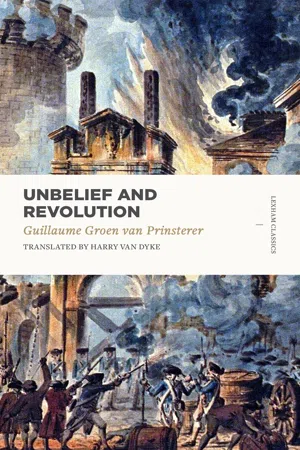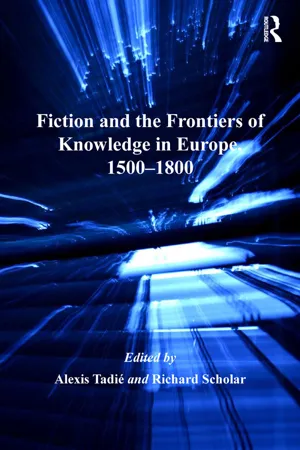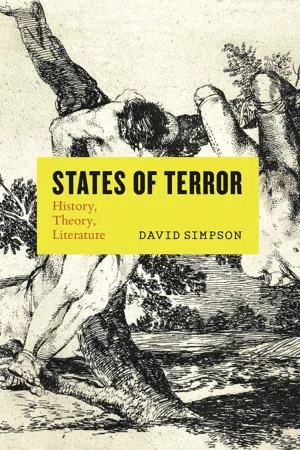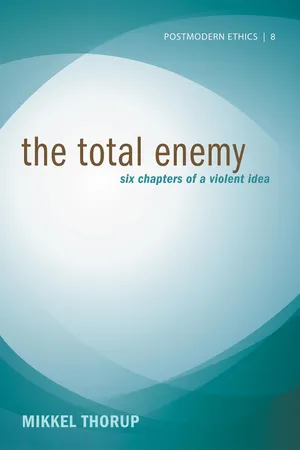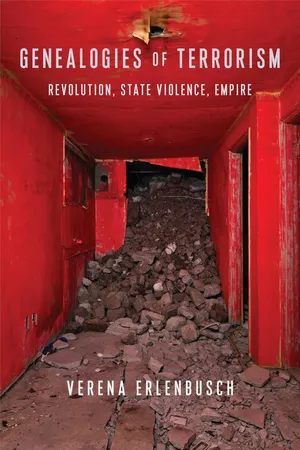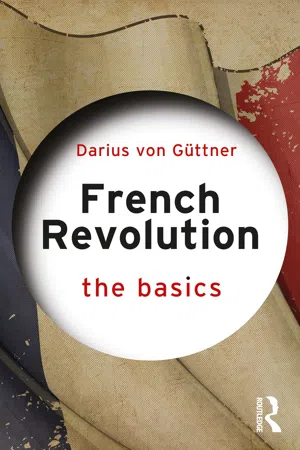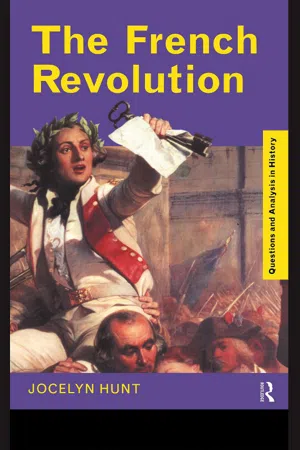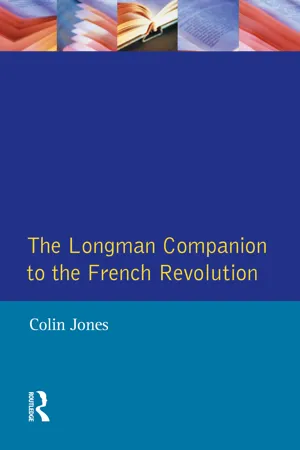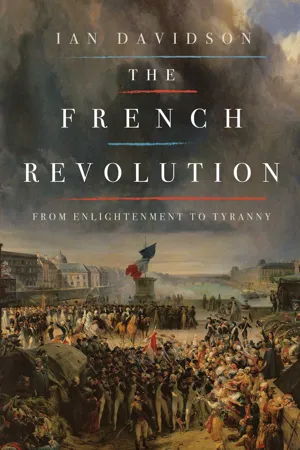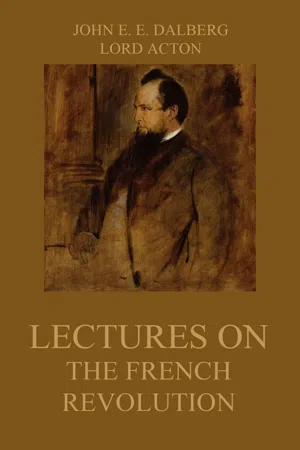History
The Reign of Terror
The Reign of Terror was a period during the French Revolution from 1793 to 1794, characterized by extreme violence and mass executions. It was led by the radical Jacobins, who sought to eliminate opposition and enforce revolutionary ideals. The Reign of Terror resulted in thousands of deaths and instilled fear and instability in France.
Written by Perlego with AI-assistance
Related key terms
Related key terms
1 of 4
Related key terms
1 of 3
12 Key excerpts on "The Reign of Terror"
- eBook - ePub
- Groen van Prinsterer, Harry Van Dyke(Authors)
- 2018(Publication Date)
- Lexham Press(Publisher)
LECTUREXIIIThe Reign of TerrorOnly one period in the phase of Development remains for us to consider: the last, the most dreadful, the most instructive of all, namely The Reign of Terror. I deem it superfluous to sketch this political descent into Inferno from the fall of the Girondins to the fall of Robespierre, 1 June 1793 to 27 July 1794 . But it is by no means redundant to draw attention to its link with the Revolution doctrine and to belie its representation as an exaggeration par excellence . We have to do here neither with an exceptional period nor with exceptional persons. In terms of issues, it was the continuation, to the farthest extent possible, of what had come to pass since 1789 ; and as for the persons, they were theorists who in the spirit of the Revolution, so far from committing excesses, proclaimed revolutionary theses and employed revolutionary means with wonderful steadiness of mind.Allow me, first, to cast a glance at the nature of this remarkable period in general, and then to discuss in greater detail some of the men who were at the head of the revolutionary development.The revolutionaries’ vilification of this period finds its explanation in their blindness to the consequences of their own dogmas. From 1789 , all governing parties were actually but nuances of the same party. Each party in turn looked upon those who supplanted it as enemies who disrupted its work, rather than as disciples and imitators who carried on with firmer step where it had halted. Each party thought it became moderate when in fact it became inconsistent. It took offence at the conclusions drawn from what it had lately preached, at the consequences of what it had lately performed. Such was the attitude of the English party to the Constitutionalists; of the Constitutionalists to the Girondins; of the Girondins to the Jacobins. Such was soon to be the attitude of everyone against the most recent faction in power. Overwhelmed by the stream they had fancied they could direct, all parties almost forgot their hatred for each other in order to transfer their hostility, indignation, abhorrence—and especially their responsibility—to the Terrorists. Disasters and atrocities were brought about, they said, because the Terrorists had abandoned the road hitherto followed. The contrary is the case. The principles were the same as those taken as guidelines not only by the Girondins but much earlier even by the Constitutionalists, by Mirabeau, Necker and Turgot, nay by the benignant king himself in his well-intentioned zeal for reform. This is true, for example, of the basic maxim that contains the keynote both of the entire theory and of the whole reign of terror: unconditional promotion of the common good or public safety. Madame de Staël at times prefers to see in this banner the maxim solely of the men of 1793 : “Arbitrary will, without limits, was their doctrine; it was enough for them to give as a pretext for every act of violence the peculiar name of their government, public safety—a fatal expression, which implies sacrificing morality to what they are agreed to call the interest of the state, that is to say, sacrificing morality to the passions of those who govern.”1 - Richard Scholar, Alexis Tadié(Authors)
- 2016(Publication Date)
- Routledge(Publisher)
1 Anne SimoninThe Terror is probably the best-known period of the French Revolution and at the same time the revolutionary event that remains the most obscure. Among historians, there is no general agreement as to when the so-called ‘Terror’ either began or ended. Nor is there general agreement as to its causes. Some believe that it was linked to circumstances, a side effect of the war declared by France on 20 April 1792, officially on ‘the king of Bohemia and Hungary’, but in fact on the Emperor of Austria. Another view, however, is that it was the by-product of a revolutionary ideology which would have turned inevitably into bloodshed with or without the war. Last but not least, there is no general agreement on the legacy of the Terror. Some accept Furet’s thesis that it heralded the totalitarian regimes of the twentieth century, while others see it as an experiment in radical democracy. As Jean-Pierre Faye has pointed out: ‘It is through the experience of the Terror that […] the State’s most dangerous state crackdown devices, but also the most delicate and the most indispensable filters of public freedom, [ …] were devised.’2If the Terror is viewed as a suspension of the legal system – whether this suspension was the result of historical circumstances or of the King’s will (an idea developed by Roman and medieval jurists) – it was nothing more than a particular kind of state of exception, or what might be described as an exceptional state of exception . The Terror was conceived under the auspices of the Revolution and at a time of war, and must be distinguished from the previous state of exception enforced under the monarchy; whereas normally a state of exception was aimed at protecting or re-establishing the previous public order, the Terror was instituted to create a new public order.3 In Robespierre’s words: ‘The aim of constitutional government is to preserve the Republic, that of the revolutionary government to build it.’4 In this sense, the Terror could be interpreted as a political act dictated by the state or states of war in which the country found itself: the external war , and the resulting occupation of the national territory by the enemies of France; and the internal war- eBook - ePub
Gothic Fiction and the Invention of Terrorism
The Politics and Aesthetics of Fear in the Age of the Reign of Terror
- Joseph Crawford(Author)
- 2013(Publication Date)
- Bloomsbury Academic(Publisher)
At the same time, people began to seek for phrases to describe the bloody year through which France had just passed. Initially, it was simply ‘the reign of Robespierre’: it suited the purposes of all sides to paint Robespierre as responsible for all the excesses of the year 1793–4, as the counter-revolutionaries wanted to have a revolutionary monster to demonise, and the men at the head of the post-Thermidorian revolutionary government wished to minimise the extent to which they, too, were implicated.69 By January 1795, the first references to ‘The Reign of Terror’ were starting to appear, becoming more frequent as the year went on, and by 1796 it was everywhere. 70 In his Considerations Upon the State of Public Affairs at the Beginning of the Year 1796 , Thomas Bentley referred to the possibility that the ‘reign of terror’ could be restored in France; The Bloody Buoy , a compendium of ‘bloody anecdotes’ concerning revolutionary atrocities published by William Cobbett in 1796, explained that ‘this murdering time ... had justly assumed the name of the reign of terror ’, while in his Examination of the Principles of the French Revolution , Jean Baptise Duvoisin asserted that the National Convention ‘vaunts itself on having destroyed The Reign of Terror’. 71In his Secret History of the French Revolution , published in English in 1797, François Xavier Pagès looked back on the confusion of factional names that had arisen in France after Thermidor:After the fall of Robespierre, the Thermidorians called their enemies, or those whom they regarded as such, Robespierrists, Terrorists, Jacobins, Blood-Drinkers, and Anarchists. The Thermidorian re-actors were in their turn called Hecatombists, or makers of Hecatombs, new Terrorists, or Furorists.72As this passage implies, while the word ‘terrorist’ was clearly used initially to refer only to members of the party of Robespierre, it was re-deployed almost immediately for use against other targets; the description of the Thermidorians as ‘new Terrorists’ implies both a recognition that they were distinct from the original terrorists (i.e. the followers of Robespierre), and an accusation that their methods were essentially the same. Pagès himself uses ‘terrorist’ as a general term for anyone attempting to further their political aims through violence and fear, including the anti-revolutionary Royalist extremists who called themselves the Society of the Sun, of whose excesses he writes: ‘Thus terror had only changed hands.’73 ‘It was natural that the terrorists, Jacobins, Cromwellists, and Robespierrists should be succeeded by other terrorists and other men of blood,’ he writes, ‘because in morals as well as in physics, action and re-action are proportionate to each other ...’.74 (Pagès makes no effort to explain what distinguishes ‘terrorists’, ‘Jacobins’, ‘Cromwellists’, and ‘Robespierrists’ from one another; evidently all were fairly interchangeable post-Thermidorian terms for the faction which had held power in 1793–4.) Indeed, so many different groups of ‘terrorists’ appear in Pagès’ narrative that he is forced to use a special term, ‘ancient terrorists’, to make clear when he is using the word to refer specifically to the party responsible for the blood-letting of 1793–4, rather than to any of the many other terror-using groups active in France during the 1790s. In a similar vein, the authors of the New Annual Register for the Year 1799 use the word ‘terrorist’ five times to refer to the Jacobins, but also refer to ‘the extremes of both parties, the terrorist jacobins and the terrorist royalists’, demonstrating that while the word was still heavily associated with the political faction responsible for the revolutionary Reign of Terror, it could also be applied, by analogy, to violent extremists of other political persuasions.75 - eBook - ePub
States of Terror
History, Theory, Literature
- David Simpson(Author)
- 2019(Publication Date)
- University of Chicago Press(Publisher)
But it is only after the fall of the Robespierrists in July 1794 that the Terror comes into focus as a term for describing a period in history that is supposed to be over. By 1798, the supplement to the Dictionnaire de l’Académie lists terrorisme for the first time as système de terreur or régime de terreur : The Reign of Terror. From there it is but a short step to popular acceptance of something called the Terror. 6 Geffroy (153) finds no instance of either terrorisme or terroriste before September 1794: the terms come into use as derogatory references to the fallen Jacobins, and by the end of the year are in popular use, along with “the terror.” François-Noël Babeuf keeps the term alive as describing the new government’s continuing intimidation of the populist movement, but it is more frequently invoked as unique to Jacobinism, and as such, according to some historians, its emergence confirms the essential logic of the entire revolution. 7 The existence of two terrors, the red and the white, the first that of 1793–1794 and the second that of the Thermidorean response, became rhetorically familiar only in the 1830s; 8 the second of these has never become comparably familiar in the popular imagination. After the second “Red Terror” of 1917, terror would again become dominantly an attribute of the communist state, and then (after the Nazi phenomenon) of absolutist states in general - eBook - ePub
The Total Enemy
Six Chapters of a Violent Idea
- Thorup(Author)
- 2015(Publication Date)
- Pickwick Publications(Publisher)
53An important part of the conceptual transformation was the use of terror as an epochal concept in the “Reign of Terror,” now understood as a state-sanctioned use of violence against one’s own population. Turning it into a epochal concept served as a way to distance oneself from the newly established stigma of terror by relegating it to the past of someone else thereby avoiding having to contemplate the terroristic dimensions of one’s own system of repression. Terror was now effectively becoming the work always of someone else.Terror was now understood as what former justice minister Dominique Garat called a “système exterminateur” [system of extermination] or as the new edition of Dictionnaire de l’ Académie française in 1798 called “système, régime de la terreur” [system, regime of terror]; likewise “terrorist” came to mean someone who wanted to reinstate the Jacobin regime and later a common conservative critique of the French revolution and the claim that all attempts to “bring heaven down on earth” will result in terror. This is also how Immanuel Kant uses it in Streit der Fakultäten from 1798 where he speaks of the “terrorist idea of human history” [der terroristische Vorstellungsart der Menschengeschichte]54 - eBook - ePub
The Afterlives of the Terror
Facing the Legacies of Mass Violence in Postrevolutionary France
- Ronen Steinberg(Author)
- 2019(Publication Date)
- Cornell University Press(Publisher)
In Robespierre’s address, the Terror was defined by the future; in Tallien’s reformulation, it was described as receding into the past. Robespierre’s articulation of the Terror was remarkably abstract. It was theoretically astute, groundbreaking even, but it was devoid of any references to the guillotine, to cadavers, and to prisons; devoid, in short, of any references to the sensory realities of the repression. In contrast, Tallien’s discussion of the Terror was intensely corporeal. It resounded with the smells, sights, and sounds of massive violence: “Death has to be rendered atrocious in order to spread fear,” he claimed. “At first the idea of hemlock suffices to terrify the imagination; soon it has to be followed by … the sight of spilled blood; then the victim must be surrounded by other victims. … A man must watch the death of fifty others before he is killed.” 81 Finally, the Thermidorian transformation of the meaning of the Terror entailed redefining its relationship to the social order. Tallien implied that all governments rely on fear and violence to a certain extent, or at least on the threat of violence, but whereas legitimate governments target people because of what they do, The Reign of Terror targeted people because of what they are - eBook - ePub
Genealogies of Terrorism
Revolution, State Violence, Empire
- Verena Erlenbusch-Anderson(Author)
- 2018(Publication Date)
- Columbia University Press(Publisher)
Citing Robespierre’s defense of terror as “prompt, severe, inflexible justice,” 9 they either argue that Robespierre embraced terrorism as an instrument to enforce the general will or observe that Robespierre’s Terror was the referent of the neologism terrorism, which was introduced by his opponents as a term of moral opprobrium. 10 On both conceptual and phenomenal accounts, terrorism emerged in the French Revolution as the name for a particular form of violence. Specifically, it designated the excessive and arbitrary use of force for political goals, exercised by a state and its representatives. In this chapter, I offer a fresh perspective on this origin story in pursuit of two goals: to identify and examine a range of conceptual uses of terrorism elaborated in the French Revolution, and to embed this explosion of discourse within an account of the emergence of a biopolitical rationality. My aim is to show that the proliferation of discourses and practices of terrorism in the short period under consideration set the stage for a continuous reworking of the French revolutionary heritage of terrorism that would eventually lead to our own historical present. To this end, I first pursue an archaeological approach and analyze discourses of terror and terrorism in order to identify various conceptual uses of the term terrorism during the French Revolution. Although it is true that terrorism entered the political vocabulary as the name for a system of government, and thus state violence, an archaeology of terrorism in the French Revolution forces us to expand the conceptual space in which the term is understood - eBook - ePub
- Darius von Güttner(Author)
- 2021(Publication Date)
- Routledge(Publisher)
The range of emergencies faced by the Republic meant that the Convention’s day-to-day executive tasks were handled by the Committee of Public Safety. After the defeat of the Girondins, the Committee’s membership changed, with a number of the Montagnard leaders, such as Robespierre and Saint-Just, replacing more moderate deputies. With the influential moderate Danton leaving the Committee, its policies became more radical. The Committee increasingly performed the function of an executive branch of government, with some members assigned to particular government departments or tasks. For example, Lazare Carnot was in charge of the war strategy and army in general. The policies of the Committee were carried out by the Representative on Mission or specially appointed agents. In the months that followed the declaration that ‘terror is the order of the day’ (5 September 1793), the Convention decreed the government of France would remain ‘revolutionary until the peace’ (10 October 1793)—revolutionary, that is dictatorial. The same decree suspended the 1793 Constitution, placing all government bodies and the army under the control of the Committee of Public Safety, which had to report weekly to the Convention. The law, argued John Hall Stewart, had fundamentally altered the nature of government in France. The citizens of the Republic had almost all individual rights suspended and were now governed by a revolutionary dictatorship. The Reign of Terror had begun.Among the extraordinary measures decreed by the Convention was the Law of Suspects enacted on 17 September 1793; it provided for setting up of surveillance committees in every département to expose the ‘unpatriotic’ and to terrorise them.34 Individuals suspected of counter-revolutionary activity could be jailed indefinitely. Following the introduction of the Law, the Revolutionary Tribunal tried and sentenced to death a number of prominent political figures. Among the first to be executed was Marie Antoinette, who was guillotined on 16 October. The 37-year-old former Queen of France was memorialised by Jacques-Louis David, seated with her hands bound behind her back in a tumbrel on the way to the guillotine, in a drawing that is pitilessly frank in contrast to the apologetic heroism of David’s ‘Death of Marat’. Jacques Hébert in Le Père Duchesne expressed his views differently: ‘The bitch was audacious and insolent right to the very end’.35 Marie Antoinette’s execution was followed by the deaths of the 21 Girondin leaders (31 October), Olympe de Gouges (3 November), the former Duke of Orléans, Philippe Égalité (7 November), Madame Roland (8 November), and the ‘men of 1789’—Bailly (12 November) and Barnave (29 November). The executions of such high-profile individuals emphasised the resolve of the Convention to eradicate all possible counter-revolution. Indeed, claims Schama, these executions were the reflection of the nature of the revolution itself, which at every stage of its development was defined by armed conflict, violence and riot.36 - eBook - ePub
- Jocelyn Hunt(Author)
- 2005(Publication Date)
- Routledge(Publisher)
Federalist and counter-revolutionary areas were dealt with efficiently and mercilessly. More than half the executions of the Terror occurred in the region of the Vendée; in Lyon, almost as many died as in Paris. Although there were a few sporadic attempts at risings after the Terror, for example the farcical Quiberon Landings of 1795, the acute threat of counter revolution was permanently crushed by Turreau. A combination of violence and propaganda brought other parts of the country under control. Couthon’s demonstration that the blood of Christ, revered as a relic in Billom, was merely coloured turpentine, and Saint-André’s new patriotic youth clubs in Brest, should be seen alongside the fusillades at Lyon, and the portable guillotine taken by Representatives on Mission to Alsace. There is no question that the Terror was successful in restoring order to the regions of France, giving the government sufficient control to continue waging war.Dealing with the ‘enemies of France’ within Paris and amongst the influential groups at the centre was a lengthier process, since the criteria of definition kept changing. It would be reasonable to suggest that the Terror failed here, since the leaders of the regime were to meet their end at the hands of dissidents. The removal of the enemies of France was pursued diligently. Throughout the period of the Terror, new regulations speeded up the process: the division of the Revolutionary Tribunal into three parallel courts increased the turnover; the new police code of Germinal II enhanced the pace of convictions, as did the Law of 22 Prairial. At first, the victims were recognisably enemies of France, such as the Queen, or the Girondins. Rapidly, however, groups seen until recently as allies of the Mountain came under attack. Roux and the Enragés, who had spearheaded the attack on the Girondins, were soon removed, and the Hébertists followed. Their extreme views were not acceptable to the property owners of the Convention, and their removal was not opposed, despite the fact that Collot, Carrier and other leading servants of the Terror had considerable sympathy with their point of view.4 - eBook - ePub
- Colin Jones(Author)
- 2014(Publication Date)
- Routledge(Publisher)
IV. The Structure of the Terror: The Institutions of Revolutionary Government, 1792–1795Passage contains an image
1. ‘Revolutionary Government’
Contemporaries took the term ‘revolutionary’ to mean not ‘pertaining to the Rev’, but rather ‘provisional’, ‘exceptional’, the opposite of ‘constitutional’. The phrase ‘rev govt’ may thus be applied to the whole period from 10 Aug 1792 to 26 Oct 1795/4 brum IV. For all this period, France was being governed outside the framework of a constitution, and for virtually all of it by a nat ass., the Convtn, specifically established to devise a rpbcn constitution. Military necessity required that the separation of powers, the keystone of any constitutional government, was provisionally in abeyance. The rpbcn constitution, finally approved on 24 June 1793, was never to be implemented: the law of 10 Oct 1793 declared that France’s system of government was to be ‘rev until the peace’; and the Thermidorian Convtn devised a less democratic constitution, the Constitution of Year IIIThe period is often referred to as the ‘Terror’, the policy and institutions of intimidation and repression of political opponents. Very crudely, four periods of ‘Rev Govt’ may be discerned.(i) The ‘First Terror’, 10 Aug–20 Sept 1792 . The emergency government which lasted from the overthrow of the monarchy to the first session of the Convtn. Power shared between Leg Ass., the Provisional Executive Council of Ministers (PEC) and the Paris Commune. Most notable event, the ‘Sept Massacres’ (2–6 Sept).(ii) Foundations of the Great Terror, 21 Sept 1792–2 June 1793 . Rule of the Convtn down to the purge of the Girondins. Most of the organs of the Terror were established: Committee of General Security (CGS) (2 Oct 1792); Rev Tribunal (10 Mar 1793), reps en mission (9 Mar), death for rebels (19 March), comités de surveillance (21 Mar), Committee of Public Safety (CPS) (6 Apr), reps aux armées (9 Apr), ‘First’ Maximum (4 May).(iii) The ‘Great Terror’, Spring/Summer 1793–9 Thermidor . The period of dominance of the CPS. The build-up of the legislative arsenal of the Terror was accelerated by the Federalist Revolt and the declaration (5 Sept 1793) that Terror was the ‘order of the day’: law on hoarding (27 July 1793), levée en masse - eBook - ePub
- Ian Davidson(Author)
- 2016(Publication Date)
- Pegasus Books(Publisher)
Of those executed, 20 per cent were members of the former (ci-devant) nobility, 9 per cent members of the clergy and 71 per cent members of the Third Estate, of whom 41 per cent were artisans and 28 per cent farmers. The vast mass of the victims of the Terror were not particularly significant, except that they had been individually marked down, no doubt by some local adversary or other, as enemies of the Revolution: four-fifths of those condemned were charged with such intangible offences as complôts (plots), attitudes, sentiments or écrits (writings), and even the possession of a picture of a crucifix could lead to the guillotine on an accusation of fanatisme religieux. 6 If such a large majority of cases was of such manifest absurdity, at least some of the proceedings of the Tribunal révolutionnaire must have occurred in a general miasma of paranoia or public hysteria. The Terror was intended to strengthen the authority of the Revolutionary Government, and in many ways it did; yet the Revolution now entered a period of frenzy and fear, of public and private accusations, of secret denunciations and betrayals, of noisy protests and furtive political conspiracies and of increasingly ferocious repression. Almost from the beginning, the policies of the Revolutionaries, starting with the wholesale disposal of Church property (biens nationaux) and the massive issue of assignats, had created conditions that could only encourage speculation and therefore corruption. Even in those early and relatively innocent days, the corruption was so widespread that Robespierre was conspicuous by not being part of it, hence his nickname: l’Incorruptible - eBook - ePub
- John Emerich Edward Dalberg, Lord Acton(Authors)
- 2016(Publication Date)
- Jazzybee Verlag(Publisher)
XVIII. The Reign of TerrorThe liberal and constitutional wave with which the Revolution began ended with the Girondins; and the cause of freedom against authority, of right against force was lost. At the moment of their fall, Europe was in arms against France by land and sea; the royalists were victorious in the west; the insurrection of the south was spreading, and Précy held Lyons with 40,000 men. The majority, who were masters in the Convention, had before them the one main purpose of increasing and concentrating power, that the country might be saved from dangers which, during those months of summer, threatened to destroy it. That one supreme and urgent purpose governed resolutions and inspired measures for the rest of the year, and resulted in the method of government which we call The Reign of Terror. The first act of the triumphant Mountain was to make a Constitution. They had criticized and opposed the Girondin draft, in April and May, and only the new declaration of the Rights of Man had been allowed to pass. All this was now re-opened. The Committee of Public Safety, strengthened by the accession of five Jacobins, undertook to prepare a scheme adapted to the present conditions, and embodying the principles which had prevailed. Taking Condorcet's project as their basis, and modifying it in the direction which the Jacobin orators had pointed to in debate, they achieved their task in a few days, and they laid their proposals before the Convention on June 10. The reporter was Hérault de Séchelles; but the most constant speaker in the ensuing debate was Robespierre. After a rapid discussion, but with some serious amendments, the Republican Constitution of 1793 was adopted, on June 24. Of all the fruits of the Revolution this is the most characteristic, and it is superior to its reputation.The Girondins, by their penman Condorcet, had omitted the name of God, and had assured liberty of conscience only as liberty of opinion. They elected the executive and the legislative alike by direct vote of the entire people, and gave the appointment of functionaries to those whom they were to govern. Primary assemblies were to choose the Council of Ministers, and were to have the right of initiating laws. The plan restricted the power of the State in the interest of decentralisation. The Committee, while retaining much of the scheme, guarded against the excess of centrifugal forces. They elected the legislature by direct universal suffrage, disfranchised domestic servants, and made the ballot optional, and therefore illusory. They resolved that the supreme executive council of twenty-four should be nominated by the legislature from a list of candidates, one chosen by indirect voting in each department, and should appoint and control all ministers and executive officers; the legislature to issue decrees with force of law in all necessary matters; but to make actual laws only under popular sanction, given or implied. In this way they combined direct democracy with representative democracy. They restricted the suffrage, abolished the popular initiative, limited the popular sanction, withdrew the executive patronage from the constituency, and destroyed secret voting. Having thus provided for the composition of power, they proceeded in the interest of personal liberty. The Press was to be free, there was to be entire religious toleration, and the right of association. Education was to become universal, and there was to be a poor law; in case of oppression, insurrection was declared a duty as well as a right, and usurpation was punishable with death. All laws were temporary, and subject to constant revision. Robespierre, who had betrayed socialist inclinations in April, revoked his earlier language, and now insisted on the security of property, proportionate and not progressive taxation, and the refusal of exemptions to the poor. In April, an unknown deputy from the Colonies had demanded that the Divinity be recognised in the preamble, and in June, after the elimination of the Girondins, the idea was adopted. At the same time, inverting the order of things, equality was made the first of the Rights of Man, and Happiness, instead of Liberty, was declared the supreme end of civil society. In point of spiritual quality, nothing was gained by the invocation of the Supreme Being.
Index pages curate the most relevant extracts from our library of academic textbooks. They’ve been created using an in-house natural language model (NLM), each adding context and meaning to key research topics.
Explore more topic indexes
Explore more topic indexes
1 of 6
Explore more topic indexes
1 of 4
